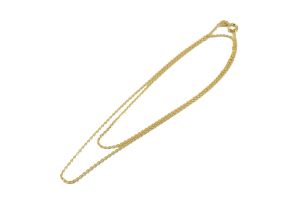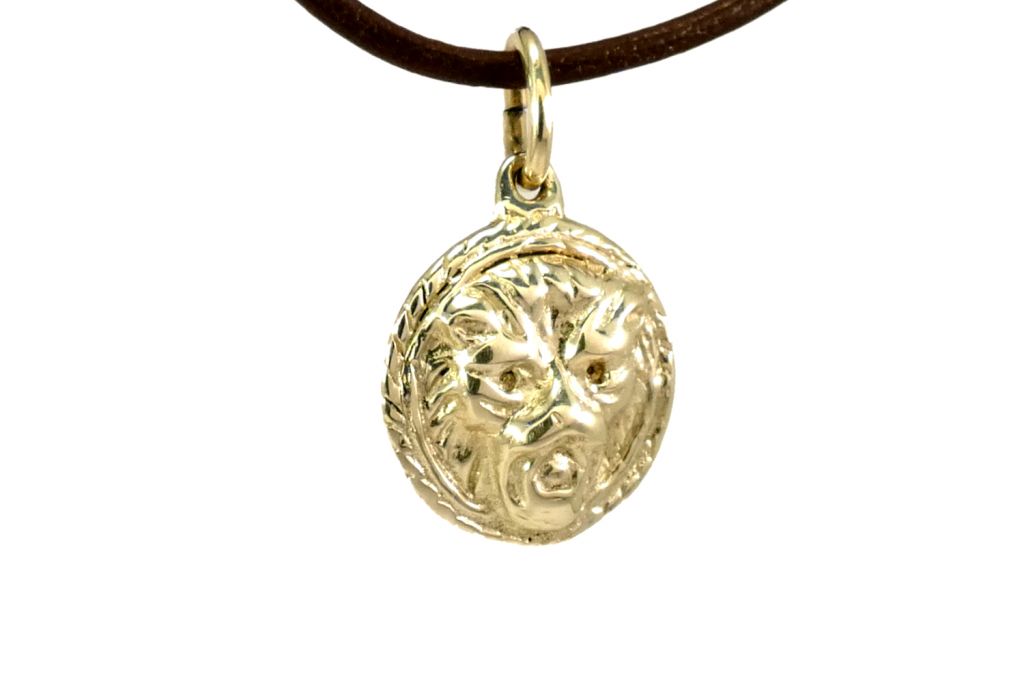Small Roman Lion Pendant, Bronze
Small roman lion pendant after a find from a roman fortress at the lower Danube. Handmade from solid gold!
Roman Lion Pendant
This product is a faithfully reproduced lion pendant from the ancient Roman Empire. The original was found at a former military camp in the lower Danube region and only had to be slightly reconstructed, as it was still in very good condition despite its age.
The pendant is handmade of solid gold in the alloy of your choice, its diameter is about 15mm. You can see the head of a lion, which opens its mouth and is surrounded by a filigree border. Above the head there is a ring, also silver, which can be used to attach the pendant to a ribbon or chain.
The lion pendant is delivered in a gift box together with a matching leather ribbon within a short time by DHL shipping.
Roman lion pendant - the symbolism
In antiquity, lions are said to have been indigenous to northern Greece, although they probably died out early on. However, the memory of the mighty beasts lived on in many legends.
The lion as a symbol of power and strength is found, for example, in the legends about Heracles / Hercules: the latter had the task of bringing down the Nemean lion, a huge and invulnerable specimen of its kind, whose fur Hercules wore as a garment after his heroic victory as a demonstration of his strength. As a trophy, the lion's skin became a hallmark of Hercules and, moreover, a symbol of martial strength and power.
Alexander the Great is said to have hunted lions in Asia Minor, and in the old tradition he too was depicted on his coins wearing a lion's skin like Heracles. In the Orient in particular, the lion was also regarded as a guardian and protector, and its statues flanked palaces and sanctuaries.
Finally, in the Roman Empire, the lion was a highlight of performances in the arena. Before the eyes of the audience, he carried out death sentences against unarmed criminals and enemies of the state in a mythical setting. As prey in bloody hunting games (venationes), specially equipped venatores tried to hunt down the lion in reconstructed landscapes. The demand for animals was so great that catching and transporting them from Africa became an extremely lucrative business.
The lion was also found in many variations in the Roman military as a symbolic animal. In the belief that the lion's strength and power passed to the wearer, lion skins were also worn by Roman field sign bearers, the signifiers, who thus also had a direct connection to the legends of antiquity.
Furthermore, Romans who had demonstrated particular bravery in the military were awarded so-called phalerae (metal plates that could be worn as jewellery or attached to a horse's harness), which, in addition to engravings of gods and emperors, could also have the shape of a lion.
This lion pendant has similarities with a (scaled-down) phalera.
Roman lion pendant - the sign of the zodiac
As a star sign, the lion was already listed in the zodiac by the Babylonians. The main star of the zodiac sign of Leo is Regulus, which is also called the Heart of the Lion in Arabic. In ancient times, zodiac signs were linked to deities; the lion, as king of the animals, was associated with the supreme god Jupiter. There was also a connection between astrology and medicine. Iatroastrology, which goes back to Greek origins, assigns the human body parts belly, back and, of the organs, the heart to the zodiac sign of Leo.
People born under the sign of Leo are said to have a natural authority and a tendency to be decisive and controlling. They are extroverted optimists with a tendency to vanity; critical faculties are not among their strengths.
| Delivery time | 3-4 weeks |
|---|---|
| weight | 0.003000 |
| size | 15 mm |
| Era | Romans |
| Material | Gold |
| Kind of replica | Pendants |
| scope of delivery | With jewellery case and leather necklace |


